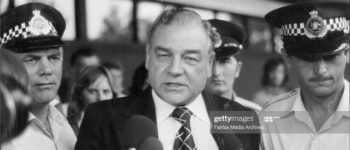1979: From Sofinsky to Putin
March 3, 2022
By AHNZ
 Back in December 1979 Communists were caught red-handed tampering with New Zealand elections. The Security Intelligence Service observed the Soviet Ambassador, Vasevolod Sofinsky, covertly passing large sums of money to the local Socialist Unity Party (SUP.) Prime Minister Rob Muldoon (National 3.0) responded to the Sofinsky Affair by booting the Ruskie out of New Zealand.
Back in December 1979 Communists were caught red-handed tampering with New Zealand elections. The Security Intelligence Service observed the Soviet Ambassador, Vasevolod Sofinsky, covertly passing large sums of money to the local Socialist Unity Party (SUP.) Prime Minister Rob Muldoon (National 3.0) responded to the Sofinsky Affair by booting the Ruskie out of New Zealand.
The SUP never did amount to much, just dregs of a once strong Communist faction in New Zealand society. They never really got over the let-down of what Stalin turned out to be or the splitting between the frenemies (the Chinese and the Soviets.)
Hard to see how funding SUP was ever a serious bit of espionage, more like charity. For a proper return on investment, Communists would be far better placed to send their money to a party like National or Labour. Then, if our SIS found out at all, who would they be able to tell?
Shadows over New Zealand from the Soviets did not begin nor end with Sofinsky. In July 1962 the diplomats Vladialov Andreev and Nicolai Shtykov were given the same treatment by National 2.0. After Sofinsky, the future Russian President Vladimir Putin apparently had the job of keeping the New Zealand File current.
Vladimir Putin’s KGB assignment during the early (or late?) 1980s involved visiting and examining New Zealand. That’s according to Bob Harvey who made the rounds for Labour 5.0 back in 2000 asking everyone under the sun attempting to establish this. Unlike his predecessors, Putin, if he was really here, managed to get around the country just fine without raising any alarms
Apparently Putin’s cover was as a salesman for Czechoslovakian international shoe company, Tomas Bata’s, New Zealand operation. Generation X fondly embraced their shoes which were branded as Bata Bullets. Whoever prepared that cover knew what they were doing: Bata shoes were a very well received brand and lots of popular advertising. It is not clear in the scattered accounts if Putin came in directly after Sofinsky’s expulsion by National 2.0 or nearer Budnik’s expulsion by Labour 4.0. Either way, his alleged mission was one that did not set off an official alert.
“What could be more natural than that Andreev, a commercial counsellor at the Soviet Legation in Wellington, should travel widely throughout New Zealand at a time when his country and the Domi- nion were entering into new trading agreements? He, after all, had negotiated sales of New Zealand mutton to Russia. What could be more natural, too, than Shtykov’s frequent trips from one part of the country to another? Weren’t Russian artists arriving in the country with increasing frequency, for concerts and other tours? Wasn’t it the job of Shtykov, as a “cultural officer”, to look after, for instance, the Moscow State Theatre group, which has just been performing here?” – The Soviet Spies, The Bulletin (21 July 1962); Trove
“New Zealand’s is the 45th case of a Western country’s declaring Soviet diplomats persona non grata…The New Zealand Government has imposed a strict security blackout on the incidents which provided the “conclusive and irrefutable proof” of the two spies’ perfidy.” – ibid
“He remembered the Bata salesman who asked everyone questions about where socialism was heading in New Zealand, and who the leading advocates and dissenters were. He wanted to know about the unions, and the chances of various politicians, and about the political direction of the country.
“The New Zealand Government today ordered the expulsion of a Soviet diplomat who it said was a K.G.B. agent. The diplomat is Sergei S. Budnik,…was announced by Prime Minister David Lange..” – New Zealand Orders Soviet Envoy to Leave, New York Times (1987)
“How can a kid climb a tree or shinny a pipe….. without their Bata Bullets. How can a kid be a kid without a pair of bullets?” – slogan from Bata Bullet TV campaign 1980s
“He remembered a man exactly like Putin with more hair who asked a lot of questions, loved chocolate biscuits and had “an eye for the ladies”. He recalled André’s interest in the young Helen Clark, a dead ringer for Joan Baez, minus the guitar. I was on my way.” – Putin and Me, Bob Harvey searches for an invisible man, Metro (2021)
Well, it’s evidence. However, I do not consider Bob Harvey as a reliable source of information by a long shot. Also, I do not recognise the man in Metro’s photo as Putin. In particular, the idea of anyone being interested in young Helen Clark and thinking she was anything like Joan Baez brings the entire article into suspicion.
—
Image ref. 24 January, 1980. Sofinsky expelled via Sydney; gettyimages.co.nz/
Image ref. Helen Clark in 1974, Nationwide: Labour Party Youth Conference, NZ on Screen
Ref. Russian Spies Leave Australia (1962,) British Pathé, Youtube
 Like Comment Share
Like Comment Share





